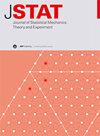应力空间分布、古登堡-里克特定律和大森-宇津定律
IF 2.2
3区 物理与天体物理
Q2 MECHANICS
Journal of Statistical Mechanics: Theory and Experiment
Pub Date : 2024-04-24
DOI:10.1088/1742-5468/ad2dd6
引用次数: 0
摘要
我们研究了一维和二维空间中的几种地震模型,并分析了这些模型中的应力空间分布。我们表明,应力分布的统计特性是地震震级分布的原因,正如古腾堡-里希特(GR)定律所描述的那样。根据应力剖面与一维随机曲线或二维随机曲面之间的类比,我们做出了一系列预测。这些预测包括 b 值,它决定了小地震事件与大地震事件的比例;在二维模型中,我们预测余震的存在及其时间分布,即所谓的 Omori-Utsu 法则。GR和Omori-Utsu定律都是已被自然界的地震观测广泛验证的属性。本文章由计算机程序翻译,如有差异,请以英文原文为准。
Stress spatial distributions, the Gutenberg–Richter and Omori–Utsu laws
We investigate several earthquake models in one and two dimensions of space and analyze in these models the stress spatial distribution. We show that the statistical properties of stress distribution are responsible for the distribution of earthquake magnitudes, as described by the Gutenberg–Richter (GR) law. A series of predictions is made based on the analogies between the stress profile and one-dimensional random curves or two-dimensional random surfaces. These predictions include the b-value, which determines the ratio of small to large seismic events and, in two-dimensional models, we predict the existence of aftershocks and their temporal distribution, known as the Omori–Utsu law. Both the GR and Omori–Utsu law are properties which have been extensively validated by earthquake observations in nature.
求助全文
通过发布文献求助,成功后即可免费获取论文全文。
去求助
来源期刊
CiteScore
4.50
自引率
12.50%
发文量
210
审稿时长
1.0 months
期刊介绍:
JSTAT is targeted to a broad community interested in different aspects of statistical physics, which are roughly defined by the fields represented in the conferences called ''Statistical Physics''. Submissions from experimentalists working on all the topics which have some ''connection to statistical physics are also strongly encouraged.
The journal covers different topics which correspond to the following keyword sections.
1. Quantum statistical physics, condensed matter, integrable systems
Scientific Directors: Eduardo Fradkin and Giuseppe Mussardo
2. Classical statistical mechanics, equilibrium and non-equilibrium
Scientific Directors: David Mukamel, Matteo Marsili and Giuseppe Mussardo
3. Disordered systems, classical and quantum
Scientific Directors: Eduardo Fradkin and Riccardo Zecchina
4. Interdisciplinary statistical mechanics
Scientific Directors: Matteo Marsili and Riccardo Zecchina
5. Biological modelling and information
Scientific Directors: Matteo Marsili, William Bialek and Riccardo Zecchina

 求助内容:
求助内容: 应助结果提醒方式:
应助结果提醒方式:


